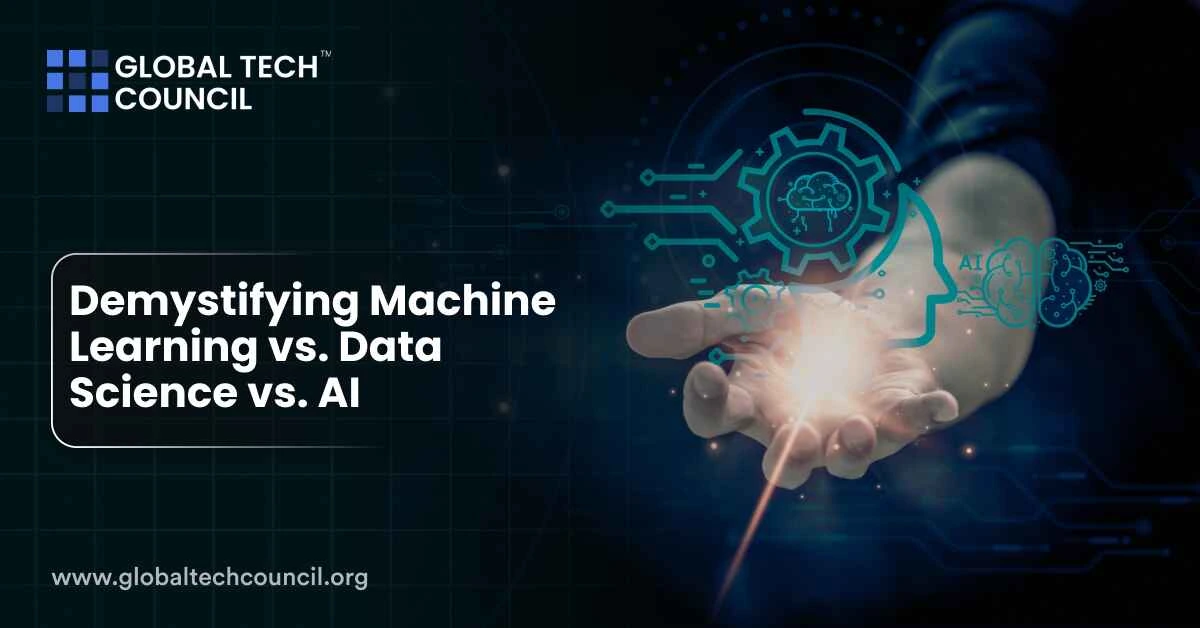
Machine Learning, Data Science, and Artificial intelligence are the buzzwords today and are often used interchangeably, but that’s not right. People from non-technical backgrounds often get confused, and their understanding seems complex. To use these technologies to their full potential, it is essential to decipher their real meaning and demystify the surrounding ambiguity.
In this article, a comprehensive explanation of what data science is, what AI embodies, and how ML is evolving fast is there. By the end, you would quickly understand these technologies, their impact, and correlation and how they are transforming business individually and collectively.
Learning of the Blog
- Data Science
- Artificial Intelligence
- Machine Learning
- ML vs. Data Science vs. AI
- Final Word
If you are remotely interested in understanding any of the three technical fields, you can check out professional certificate programs by Global Tech Council.
Data Science
In technical language, data science refers to extracting relevant insights from data. Data Science uses a pool of technologies like machine learning, data engineering, and visualization, statistical modeling, mathematics, cloud computing, etc. Data science is the most popularly used technology among the three. Data scientists are skilled practitioners of mathematics, programming, and statistics who solve complex data problems relevant to businesses. Data science involves working with structured and unstructured data based on analytical evidence. It is used for predictive analysis, tactical optimization, recommendation, and automatic decision making systems like Netflix and social research. Data science is about data selection, preparation, and analysis from large volumes of raw data. A data science expert has expertise in quality control, industrial engineering, computational finance, and number theory, which is just the tip of the iceberg.
Artificial Intelligence
Artificial Intelligence is all about imparting human intellect to a machine. From chess-playing apps to voice recognition systems like Amazon Alexa, AI is present everywhere. The focus is on making devices smart and thinks the way humans do-probably better. This is done by creating an artificial neural network showing human intelligence. An AI machine can perform functions like self-correction, learning, and logical reasoning. To make machines smart, we require a lot of computing power and data. The two parts of Artificial Intelligence are general and narrow Artificial Intelligence. General AI involves a wide array of activities that give the machine power to think and reason.
On the other hand, Narrow AI involves using artificial intelligence for a particular task. If general AI is about training the machine to play all board games, then narrow AI limits a specific game’s capabilities such as scrabble. Currently, narrow AI is within reach of an artificial intelligence expert, but general AI is far off dream. AI applications range from natural language processing to reinforcement analysis. Robots and self-driving cars are examples. An artificial intelligence developer works with frameworks like PyTorch, TensorFlow, etc.
Machine Learning
A computer system’s ability to learn from the environment and improve from experiences itself is called Machine Learning. The focus of ML is to enable algorithms to learn from provided data, search for insights, and make predictions on previously unanalyzed data. Machine learning has several approaches, but the three primary models are supervised, unsupervised, and reinforcement learning. Labeled data is available to the machine to recognize patterns in case of supervised learning. In unsupervised learning, unlabelled data is fed to the machine. The machine has to classify the data based on common characteristics. Reinforcement learning mainly used in gaming allows machines to interact with the environment and reward in case of a correct action or penalize otherwise. Machine learning is more about feeding data to a general algorithm and building logic than coding. ML has made programming scalable and time-efficient. It also improves the service of recommendation systems by exploiting predictive analysis and understanding users’ preferences. A machine learning expert works with analytical algorithms after cleaning and preparing data for modeling. They translate data insights into business value.
ML vs. Data Science vs. AI
It’s time to see what’s similar and contrasting among these widely used technologies—the application of artificial range from text analysis to robotics. Machine learning is a subset of AI focusing on a small range of activities. Data science is not a subset of machine learning. However, it uses it for data analysis and predictions by combining it with other disciplines like cloud computing. Machine learning is the only artificial intelligence with real-world applications. Data science is the practical application of machine learning.
There is a sophisticated relationship between the three distinct fields. Machine learning connects AI with Data Science. AI and ML share a hierarchical relationship. Data science is an interdisciplinary field starting from data analysis, top-level AI automation, and then working the way down to deep learning. Thus, the broad field of AI and its subfields are the solutions enabled for Data Science. The significant difference between a Certified Machine Learning Expert and a data scientist is that ML expert remains preoccupied with useful algorithms. The data scientist is more flexible. The overlapping feature of data science and AI is data. As AI and ML provide solutions to business problems, the data scientist uses visualization to present these results to the business audience.
Final Word
So, this is how the whole data technologies correlation works. In this competitive business environment, choosing one technology isn’t possible. Machine learning and data science go hand in hand, and we can’t use ML for self-learning skipping AI. AI makes devices with intelligence like the human brain, and machine learning algorithms enable this learning. If you want to explore these fields, you can look for artificial intelligence training or data science training or machine learning for beginners.
